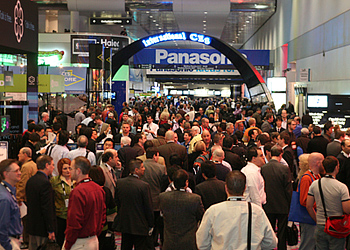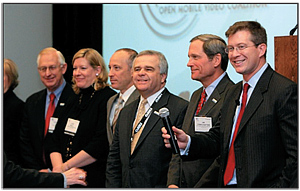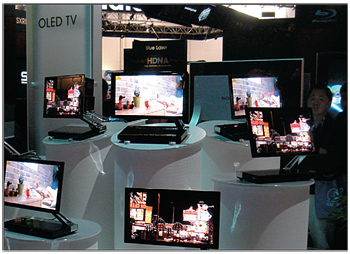CES Shows Resilience
LAS VEGAS
Novartis, the Swiss pharmaceutical maker, may be a big winner from the U.S. digital TV transition—whenever it happens. At a Consumer Electronics Show panel about "The End of Analog," panelists were asked whether they would be drinking martinis or Maalox (which Novartis manufactures) on Feb. 18, the morning after the scheduled analog cutoff.
Every panelist, and many audience members, expect to be sipping (or chugging) the chalky heartburn medication. President Barack Obama's proposal (which surfaced on CES' opening day) to postpone the analog TV cutoff triggered unanticipated consternation at the annual electronics extravaganza—especially now that broadcasting, cable TV, Hollywood and so many other industries are part of the conversation. The best that some panelists could do was to shrug off the possible postponement, noting that more than 90 percent of Americans will be unaffected by the transition, whenever it occurs.

The DTV transition brouhaha brought an unexpected urgency to an otherwise impressive but rather mellow CES. With a preliminary tally of about 110,000 attendees, the crowd was at least 20 percent smaller than last year.
Among the standout developments:
Mobile DTV found a bright spotlight, with prototypes of handheld receivers for local broadcasts and a promise of initial rollout late this year.
The frenzy of recent years about digital monitor size shifted dimension. Instead of brandishing bigger, wider screens, TV makers are now emphasizing thinner monitors—less than a halfinch in some cases. More Organic Light Emitting Diode (OLED) screens appeared, but they are still very small, as well as thin—and flexible.
And the march of integrated Internet-enabled TV sets continues, with program suppliers on hand to cut deals that will feed their content via the Web directly into living room TV monitors. Among the most notable developments in this category was the revival of the General Electric brand on TV sets—accompanied by Internet video feeds from NBC Universal (and its Hulu.com offshoot), which is owned by GE.
Elsewhere around the sprawling CES exhibit floor and in secluded demonstration suites, there were abundant updates on 3D TV, digital video recording and a variety of wireless home network systems (see "Home Networking HDTV," p. 12). There were fewer conceptual exhibits, attributing to exhibitors focusing on here-and-now products for the economic climate that will be tough on digital retailing.
Gary Shapiro, president of the Consumer Electronics Association, which produces CES, acknowledged that overall industry sales will drop by about 0.6 percent this year, compared to 2008 levels; last year's industrywide sales climbed 5.4 percent above 2007. Shapiro attributed this year's revenue decline to falling prices, which will offset a small growth in unit sales.
"Our industry is resilient," Shapiro said in his keynote remarks, calling the industry a "bright light" which is not seeking government relief. He cited 20,000 new products debuting at the show.

Broadcast industry representatives gathered at CES to announce mobile DTV progress.OMVC PUSHES MOBILE AGENDA
The Open Mobile Video Coalition, an organization of broadcasters targeting mobile DTV, announced that 63 TV stations in 22 markets will introduce MDTV services, with some launching transmissions by autumn. Collectively the stations reach about 35 percent of U.S. homes.
About 95 percent of the technical capabilities of the ATSC Candidate Standard, adopted about a week before CES, were on display during the show.
Brandon Burgess, OMVC president and ION Media Networks CEO/Chairman, said that "free-to-air" transmissions are "a good starting point," but acknowledged that stations are exploring subscription models and other business plans for MDTV transmissions of video and data. OMVC stations are talking to Nielsen about ratings for mobile viewing; Nielsen has set up a unit in its San Francisco office to measure MDTV, although no details are yet available.
Burgess admitted that "lots more work" must be done to develop relationships with mobile phone carriers and big box retailers that also touch the consumers whom MDTV broadcasters are seeking to reach. He indicated that it will take 6-10 months to develop strategies for such connections. Mark Aitken, director of Advanced Technology, Sinclair Broadcast Group, emphasized that the process is a "chicken/egg" situation, and the "Broadcasters are saying that we'll be the ones" to initiate the MDTV launch.
Responding to a question about MDTV competition with other emerging mobile video formats and services, Glenn Reitmeier, vice president of Technology Standards, Policy & Strategy at NBC Universal, focused on the "ease of integration with streaming" mobile video, which "opens the doors" for mobile broadcasting.

More OLED monitors were exhibited on the CES show floor including these screens from Sony. Accompanying the MDTV line-up of broadcasters were equipment makers, including LG Electronics, Samsung, Harris Corp. and Kenwood USA. They demonstrated prototype receivers—including phone handsets, laptops and other devices—that are being equipped to receive the MDTV signals. John Godfrey, vice president at Samsung Electronics, called MDTV technology "completely complementary" with DTV. Mark Richer of the Advanced TV Systems Committee, which coordinated the MDTV Candidate Standard, added, "If you do it correctly, consumers won't know where [the signal] comes from."
Harris said that its ATSC Mobile DTV technology platform—with 100 percent of its features—will be available by early March, and presumably on display at the NAB convention here in April. Visteon, which makes automotive entertainment systems, demonstrated in-vehicle receivers, including ones that offer premium content with conditional access.
Stations in most major markets will take part in the MDTV rollout later this year. The OMVC city-by-city roster of participating stations does not include any broadcasters in Los Angeles, Dallas, Houston, Phoenix or Minneapolis (among top 15 markets), even though OMVC member companies such as NBC, Fox, ION, PBS and Belo own stations in those markets.
3D, OLED & CONNECTED
Three-dimensional TV, which has floated through CES for years, appeared closer to market, thanks to products from Sony, Panasonic, LG and other major brands.
"3D is not a gimmick. In the future, people will use 3D in everything," said Oscar-winning director James Cameron in a recorded testimonial as Panasonic unveiled its HDTV sets with three dimensional features. Sony CEO Howard Stringer included a similar pitch for 3D in his expansive remarks about the next features in TV sets. Several videogame makers and monitor suppliers also showed off 3D products, most of which required use of polarized eyeglasses.
The looming availability of 3D home sets continued the debate about whether 3D will catch on in homes, or whether it is still primarily a digital cinema option. Cameron is producing a 3D "Avatar" movie, due in theaters at year-end.
Elsewhere on the display scene, Sony expanded its attention to OLED technology, showing a "bendable" small screen, suited for mobile devices and electronic books. It did not update its 25-inch OLED prototype shown last year. Samsung also showed OLED technology, and the OLED Association, issued a roster of "OLED Myths and Misunderstandings."
Meanwhile, "thin is in" was the mantra throughout CES, as dozens of companies offered LED and plasma monitors in the half-inch to threequarters inch depth.
The connected home—especially wireless links to video devices and Internet-connected TV sets—was on display throughout CES. Panasonic is building its VieraCast feature—with an Ethernet connection—into all its large-format plasma sets. Samsung unveiled LED HDTV sets with Web widgets from Yahoo!, intended to bring a "cinematic Internet" to consumers.
Toshiba introduced its "Cell TV technology" that uses IBM's high-powered Cell processor to enable recording and display of multiple HDTV programs. The company also says it will introduce its first Widget-enabled IPTV products by yearend.
SlingMedia, owned by Dish Network, showcased its new "SlingLoaded "HD DuoDVR," which it called the first high definition digital video recorder that can handle placeshifting. The VIP 922 model lets viewers watch and control TV shows from anywhere in the world via a broadband connection.
Anne Sweeney, president of the Disney-ABC Television Group, underscored the continuing integration of TV/video and Internet services.
"There are… many unanswered questions about how this will work, what kind of legal issues are involved and what it could ultimately mean to my business," said Sweeney after describing a new alliance with Intel and Yahoo to put Web-style widgets on TV sets.
She extolled the opportunity to "make TV viewing more functional and more fun" via the real-time overlays, interactive and social-network features that will be offered through the new relationship. Sweeney described how the widgets could enhance the final episode of "Lost," giving fans "insights into the show." And she also noted that the technology creates the potential for new advertising revenue.
In saying that, Sweeney refrained a theme of this year's CES: Seek ways to integrate and deploy technology that has been around a while to find new financial sources.
The professional video industry's #1 source for news, trends and product and tech information. Sign up below.
Gary Arlen, a contributor to Broadcasting & Cable, NextTV and TV Tech, is known for his visionary insights into the convergence of media + telecom + content + technology. His perspectives on public/tech policy, marketing and audience measurement have added to the value of his research and analyses of emerging interactive and broadband services. Gary was founder/editor/publisher of Interactivity Report, TeleServices Report and other influential newsletters; he was the long-time “curmudgeon” columnist for Multichannel News as well as a regular contributor to AdMap, Washington Technology and Telecommunications Reports; Gary writes regularly about trends and media/marketing for the Consumer Technology Association's i3 magazine plus several blogs.

